Winter 2020 Research Proposal: Improving Hand Hygiene Practices
VerifiedAdded on 2022/08/12
|11
|3203
|21
Report
AI Summary
This research proposal outlines a study aimed at improving hand hygiene compliance among resident physicians in hospitals. The introduction highlights the significance of hand hygiene in preventing hospital-acquired infections (HAIs), which lead to increased mortality, morbidity, and healthcare costs. The study's specific aims involve assessing current hand hygiene practices, evaluating the effectiveness of interventions like SMS messages and online videos, and improving the quality of clinical care. The background section emphasizes the prevalence of HAIs and the importance of hand hygiene as a cost-effective preventive measure. The methodology employs a mixed-methods approach, including a cultural behavioral theory and regression analysis, to assess the impact of interventions on resident physicians' behavior. The study will involve a sample of 91 residents, utilizing surveys, text message reminders, and video training. Statistical analysis will be conducted using IBM SPSS. Ethical considerations and study limitations are also addressed, underscoring the importance of patient safety and the potential impact of the research on healthcare practices.
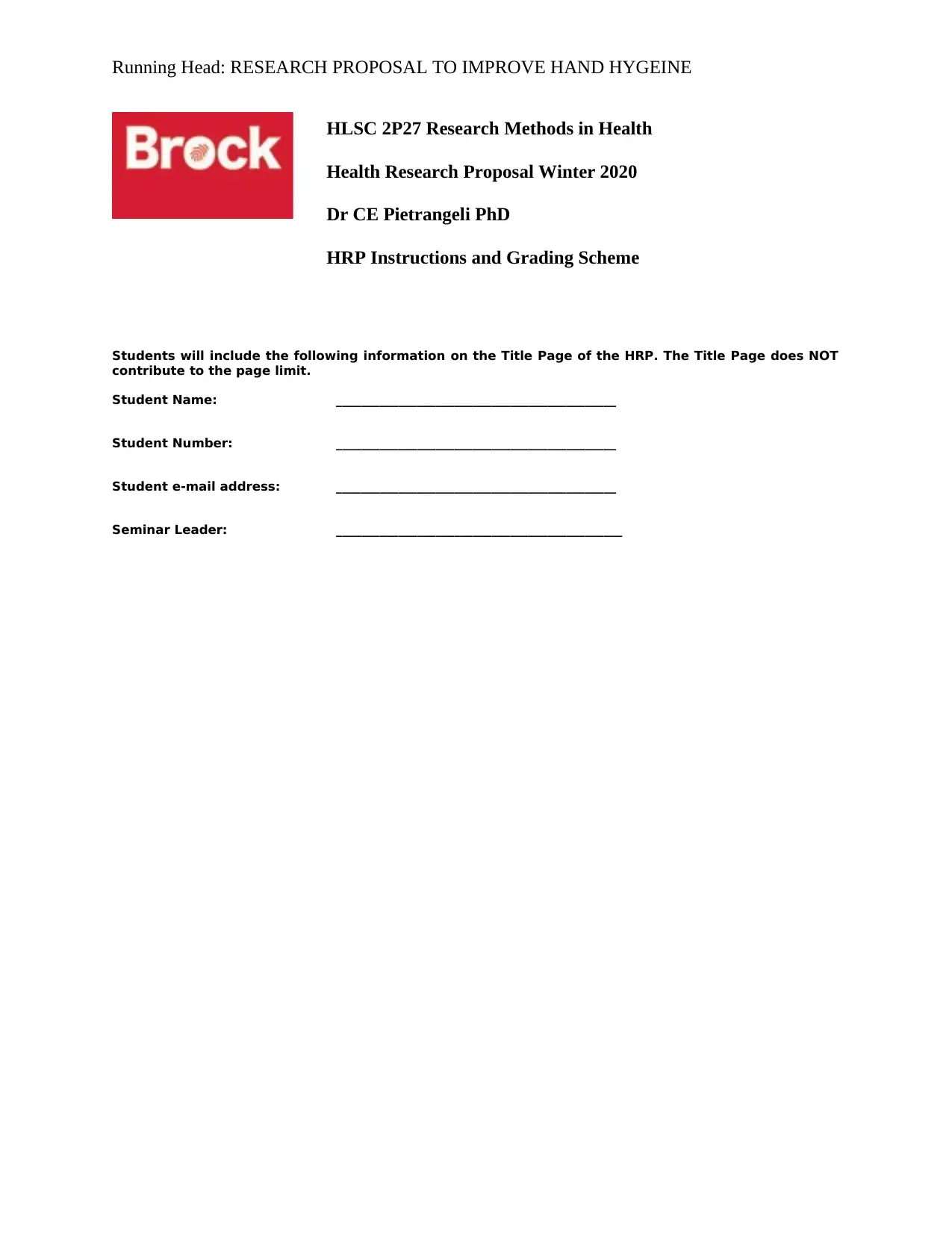
Running Head: RESEARCH PROPOSAL TO IMPROVE HAND HYGEINE
Students will include the following information on the Title Page of the HRP. The Title Page does NOT
contribute to the page limit.
Student Name: _____________________________________________
Student Number: _____________________________________________
Student e-mail address: _____________________________________________
Seminar Leader: ______________________________________________
HLSC 2P27 Research Methods in Health
Health Research Proposal Winter 2020
Dr CE Pietrangeli PhD
HRP Instructions and Grading Scheme
Students will include the following information on the Title Page of the HRP. The Title Page does NOT
contribute to the page limit.
Student Name: _____________________________________________
Student Number: _____________________________________________
Student e-mail address: _____________________________________________
Seminar Leader: ______________________________________________
HLSC 2P27 Research Methods in Health
Health Research Proposal Winter 2020
Dr CE Pietrangeli PhD
HRP Instructions and Grading Scheme
Paraphrase This Document
Need a fresh take? Get an instant paraphrase of this document with our AI Paraphraser
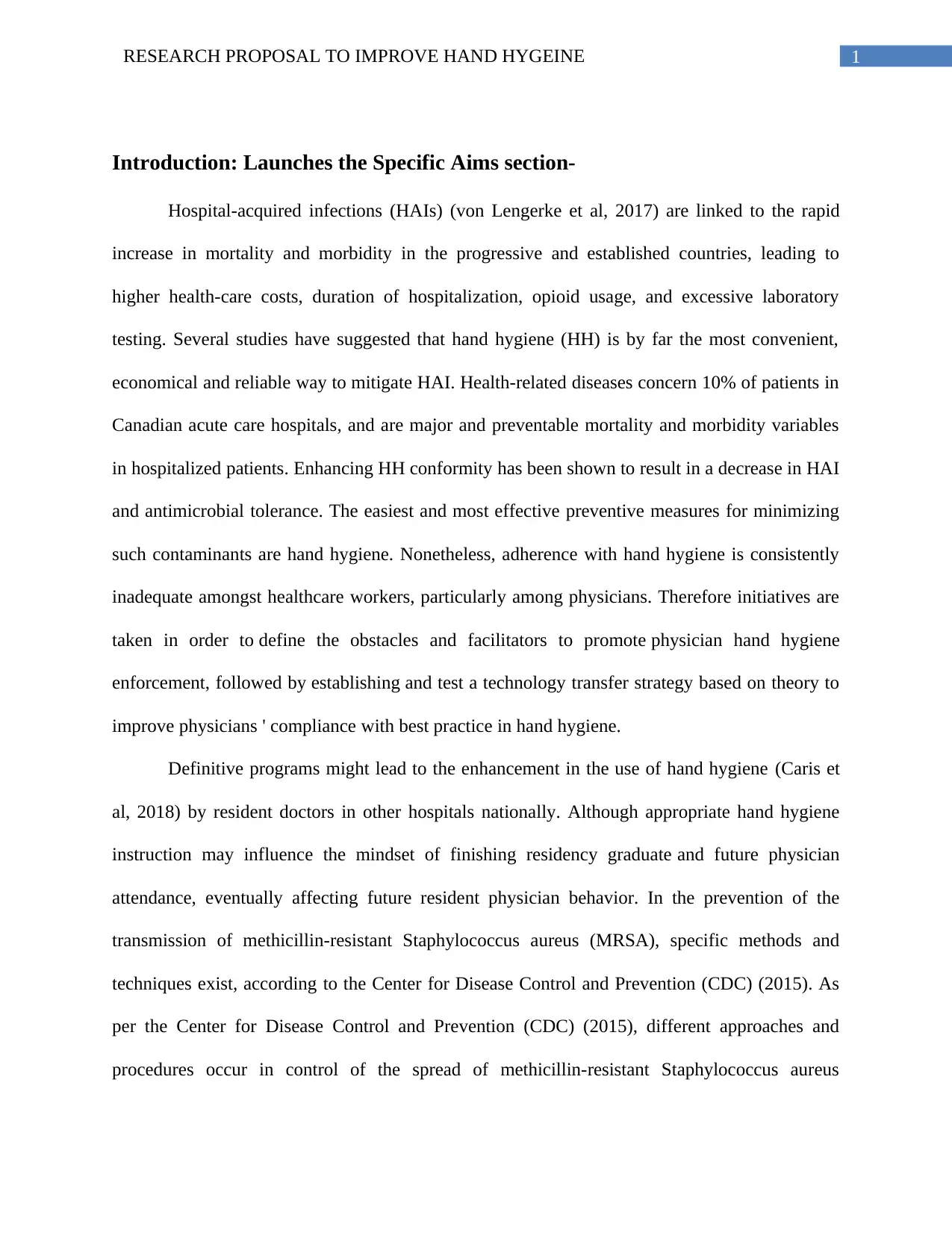
1RESEARCH PROPOSAL TO IMPROVE HAND HYGEINE
Introduction: Launches the Specific Aims section-
Hospital-acquired infections (HAIs) (von Lengerke et al, 2017) are linked to the rapid
increase in mortality and morbidity in the progressive and established countries, leading to
higher health-care costs, duration of hospitalization, opioid usage, and excessive laboratory
testing. Several studies have suggested that hand hygiene (HH) is by far the most convenient,
economical and reliable way to mitigate HAI. Health-related diseases concern 10% of patients in
Canadian acute care hospitals, and are major and preventable mortality and morbidity variables
in hospitalized patients. Enhancing HH conformity has been shown to result in a decrease in HAI
and antimicrobial tolerance. The easiest and most effective preventive measures for minimizing
such contaminants are hand hygiene. Nonetheless, adherence with hand hygiene is consistently
inadequate amongst healthcare workers, particularly among physicians. Therefore initiatives are
taken in order to define the obstacles and facilitators to promote physician hand hygiene
enforcement, followed by establishing and test a technology transfer strategy based on theory to
improve physicians ' compliance with best practice in hand hygiene.
Definitive programs might lead to the enhancement in the use of hand hygiene (Caris et
al, 2018) by resident doctors in other hospitals nationally. Although appropriate hand hygiene
instruction may influence the mindset of finishing residency graduate and future physician
attendance, eventually affecting future resident physician behavior. In the prevention of the
transmission of methicillin-resistant Staphylococcus aureus (MRSA), specific methods and
techniques exist, according to the Center for Disease Control and Prevention (CDC) (2015). As
per the Center for Disease Control and Prevention (CDC) (2015), different approaches and
procedures occur in control of the spread of methicillin-resistant Staphylococcus aureus
Introduction: Launches the Specific Aims section-
Hospital-acquired infections (HAIs) (von Lengerke et al, 2017) are linked to the rapid
increase in mortality and morbidity in the progressive and established countries, leading to
higher health-care costs, duration of hospitalization, opioid usage, and excessive laboratory
testing. Several studies have suggested that hand hygiene (HH) is by far the most convenient,
economical and reliable way to mitigate HAI. Health-related diseases concern 10% of patients in
Canadian acute care hospitals, and are major and preventable mortality and morbidity variables
in hospitalized patients. Enhancing HH conformity has been shown to result in a decrease in HAI
and antimicrobial tolerance. The easiest and most effective preventive measures for minimizing
such contaminants are hand hygiene. Nonetheless, adherence with hand hygiene is consistently
inadequate amongst healthcare workers, particularly among physicians. Therefore initiatives are
taken in order to define the obstacles and facilitators to promote physician hand hygiene
enforcement, followed by establishing and test a technology transfer strategy based on theory to
improve physicians ' compliance with best practice in hand hygiene.
Definitive programs might lead to the enhancement in the use of hand hygiene (Caris et
al, 2018) by resident doctors in other hospitals nationally. Although appropriate hand hygiene
instruction may influence the mindset of finishing residency graduate and future physician
attendance, eventually affecting future resident physician behavior. In the prevention of the
transmission of methicillin-resistant Staphylococcus aureus (MRSA), specific methods and
techniques exist, according to the Center for Disease Control and Prevention (CDC) (2015). As
per the Center for Disease Control and Prevention (CDC) (2015), different approaches and
procedures occur in control of the spread of methicillin-resistant Staphylococcus aureus
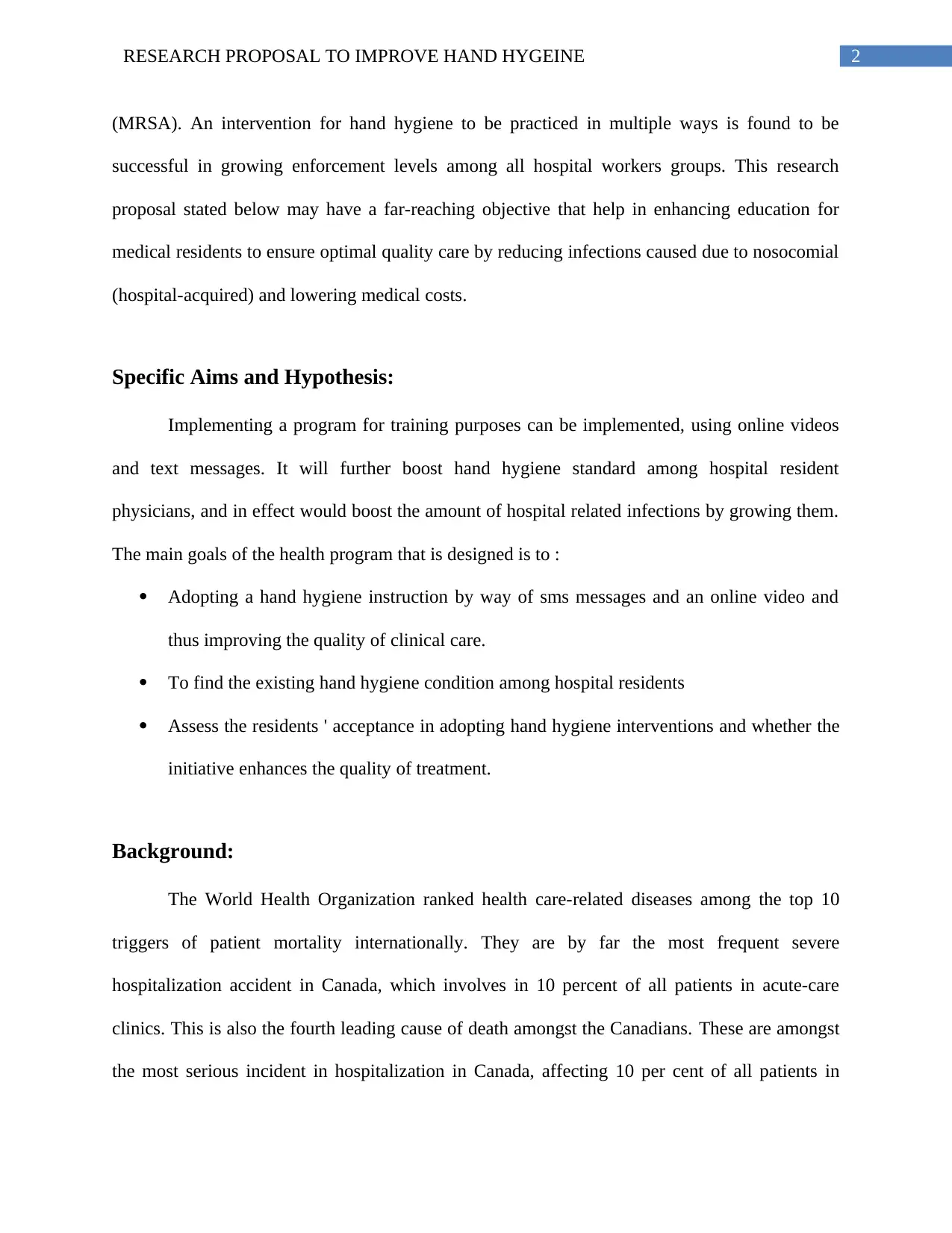
2RESEARCH PROPOSAL TO IMPROVE HAND HYGEINE
(MRSA). An intervention for hand hygiene to be practiced in multiple ways is found to be
successful in growing enforcement levels among all hospital workers groups. This research
proposal stated below may have a far-reaching objective that help in enhancing education for
medical residents to ensure optimal quality care by reducing infections caused due to nosocomial
(hospital-acquired) and lowering medical costs.
Specific Aims and Hypothesis:
Implementing a program for training purposes can be implemented, using online videos
and text messages. It will further boost hand hygiene standard among hospital resident
physicians, and in effect would boost the amount of hospital related infections by growing them.
The main goals of the health program that is designed is to :
Adopting a hand hygiene instruction by way of sms messages and an online video and
thus improving the quality of clinical care.
To find the existing hand hygiene condition among hospital residents
Assess the residents ' acceptance in adopting hand hygiene interventions and whether the
initiative enhances the quality of treatment.
Background:
The World Health Organization ranked health care-related diseases among the top 10
triggers of patient mortality internationally. They are by far the most frequent severe
hospitalization accident in Canada, which involves in 10 percent of all patients in acute-care
clinics. This is also the fourth leading cause of death amongst the Canadians. These are amongst
the most serious incident in hospitalization in Canada, affecting 10 per cent of all patients in
(MRSA). An intervention for hand hygiene to be practiced in multiple ways is found to be
successful in growing enforcement levels among all hospital workers groups. This research
proposal stated below may have a far-reaching objective that help in enhancing education for
medical residents to ensure optimal quality care by reducing infections caused due to nosocomial
(hospital-acquired) and lowering medical costs.
Specific Aims and Hypothesis:
Implementing a program for training purposes can be implemented, using online videos
and text messages. It will further boost hand hygiene standard among hospital resident
physicians, and in effect would boost the amount of hospital related infections by growing them.
The main goals of the health program that is designed is to :
Adopting a hand hygiene instruction by way of sms messages and an online video and
thus improving the quality of clinical care.
To find the existing hand hygiene condition among hospital residents
Assess the residents ' acceptance in adopting hand hygiene interventions and whether the
initiative enhances the quality of treatment.
Background:
The World Health Organization ranked health care-related diseases among the top 10
triggers of patient mortality internationally. They are by far the most frequent severe
hospitalization accident in Canada, which involves in 10 percent of all patients in acute-care
clinics. This is also the fourth leading cause of death amongst the Canadians. These are amongst
the most serious incident in hospitalization in Canada, affecting 10 per cent of all patients in
⊘ This is a preview!⊘
Do you want full access?
Subscribe today to unlock all pages.

Trusted by 1+ million students worldwide
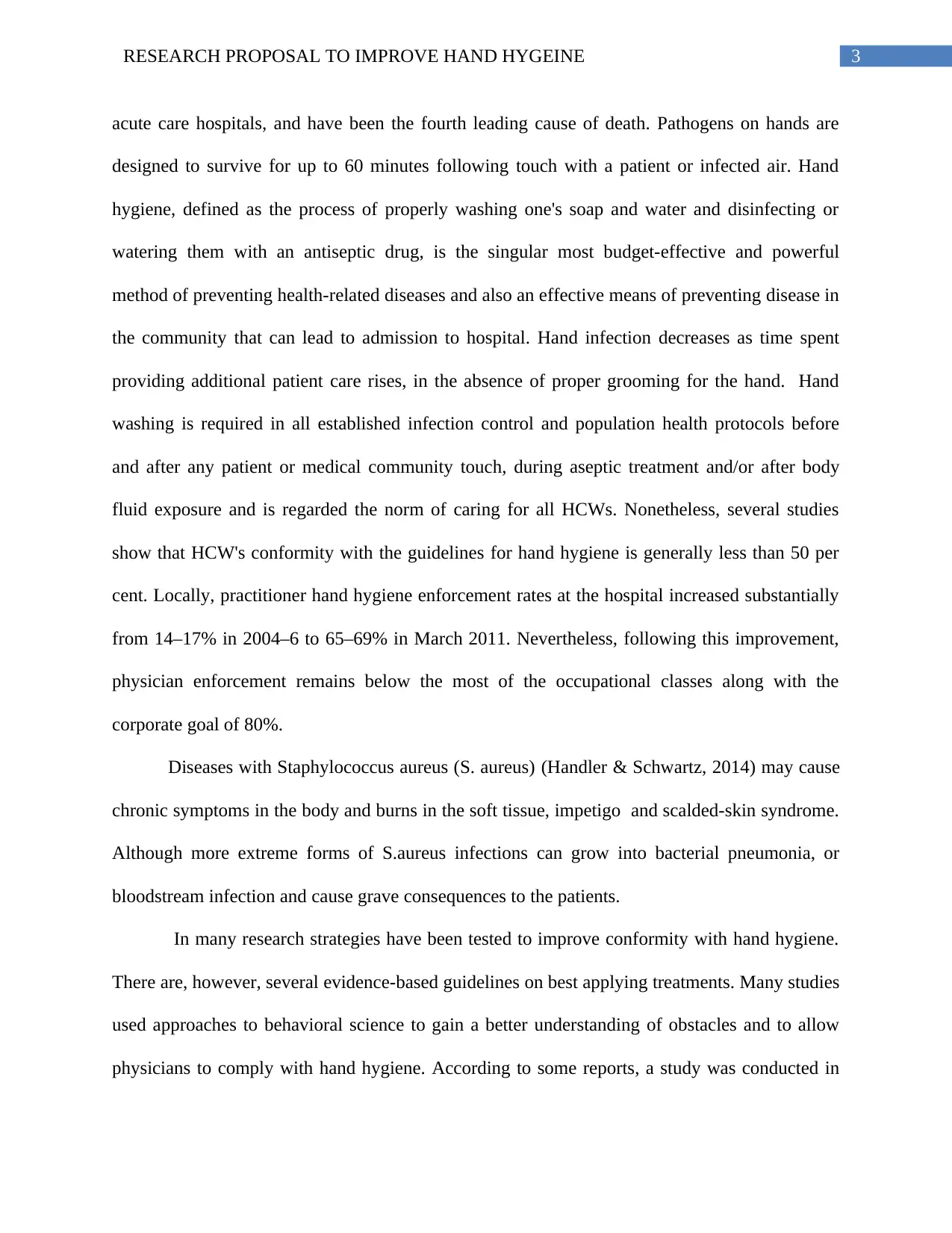
3RESEARCH PROPOSAL TO IMPROVE HAND HYGEINE
acute care hospitals, and have been the fourth leading cause of death. Pathogens on hands are
designed to survive for up to 60 minutes following touch with a patient or infected air. Hand
hygiene, defined as the process of properly washing one's soap and water and disinfecting or
watering them with an antiseptic drug, is the singular most budget-effective and powerful
method of preventing health-related diseases and also an effective means of preventing disease in
the community that can lead to admission to hospital. Hand infection decreases as time spent
providing additional patient care rises, in the absence of proper grooming for the hand. Hand
washing is required in all established infection control and population health protocols before
and after any patient or medical community touch, during aseptic treatment and/or after body
fluid exposure and is regarded the norm of caring for all HCWs. Nonetheless, several studies
show that HCW's conformity with the guidelines for hand hygiene is generally less than 50 per
cent. Locally, practitioner hand hygiene enforcement rates at the hospital increased substantially
from 14–17% in 2004–6 to 65–69% in March 2011. Nevertheless, following this improvement,
physician enforcement remains below the most of the occupational classes along with the
corporate goal of 80%.
Diseases with Staphylococcus aureus (S. aureus) (Handler & Schwartz, 2014) may cause
chronic symptoms in the body and burns in the soft tissue, impetigo and scalded-skin syndrome.
Although more extreme forms of S.aureus infections can grow into bacterial pneumonia, or
bloodstream infection and cause grave consequences to the patients.
In many research strategies have been tested to improve conformity with hand hygiene.
There are, however, several evidence-based guidelines on best applying treatments. Many studies
used approaches to behavioral science to gain a better understanding of obstacles and to allow
physicians to comply with hand hygiene. According to some reports, a study was conducted in
acute care hospitals, and have been the fourth leading cause of death. Pathogens on hands are
designed to survive for up to 60 minutes following touch with a patient or infected air. Hand
hygiene, defined as the process of properly washing one's soap and water and disinfecting or
watering them with an antiseptic drug, is the singular most budget-effective and powerful
method of preventing health-related diseases and also an effective means of preventing disease in
the community that can lead to admission to hospital. Hand infection decreases as time spent
providing additional patient care rises, in the absence of proper grooming for the hand. Hand
washing is required in all established infection control and population health protocols before
and after any patient or medical community touch, during aseptic treatment and/or after body
fluid exposure and is regarded the norm of caring for all HCWs. Nonetheless, several studies
show that HCW's conformity with the guidelines for hand hygiene is generally less than 50 per
cent. Locally, practitioner hand hygiene enforcement rates at the hospital increased substantially
from 14–17% in 2004–6 to 65–69% in March 2011. Nevertheless, following this improvement,
physician enforcement remains below the most of the occupational classes along with the
corporate goal of 80%.
Diseases with Staphylococcus aureus (S. aureus) (Handler & Schwartz, 2014) may cause
chronic symptoms in the body and burns in the soft tissue, impetigo and scalded-skin syndrome.
Although more extreme forms of S.aureus infections can grow into bacterial pneumonia, or
bloodstream infection and cause grave consequences to the patients.
In many research strategies have been tested to improve conformity with hand hygiene.
There are, however, several evidence-based guidelines on best applying treatments. Many studies
used approaches to behavioral science to gain a better understanding of obstacles and to allow
physicians to comply with hand hygiene. According to some reports, a study was conducted in
Paraphrase This Document
Need a fresh take? Get an instant paraphrase of this document with our AI Paraphraser
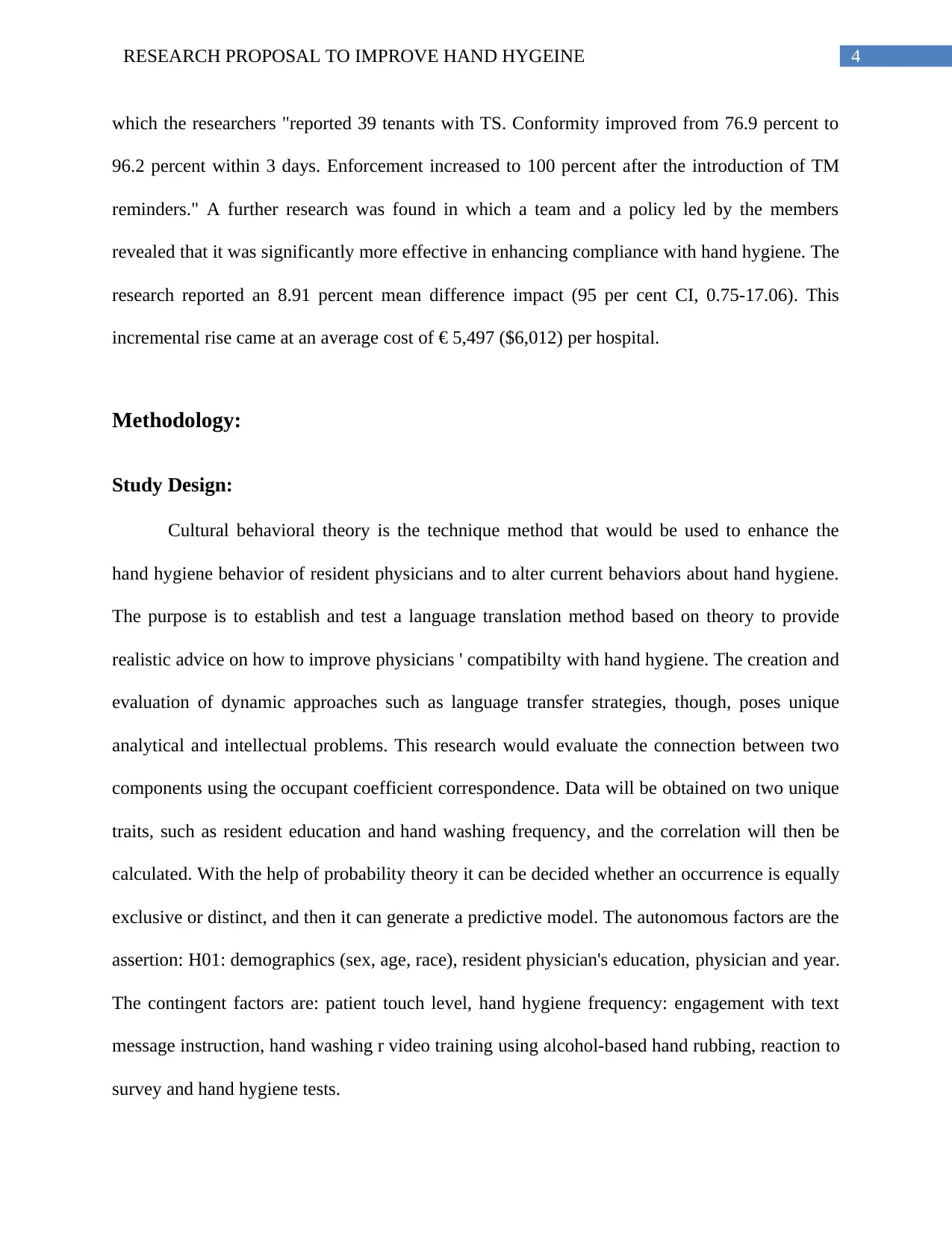
4RESEARCH PROPOSAL TO IMPROVE HAND HYGEINE
which the researchers "reported 39 tenants with TS. Conformity improved from 76.9 percent to
96.2 percent within 3 days. Enforcement increased to 100 percent after the introduction of TM
reminders." A further research was found in which a team and a policy led by the members
revealed that it was significantly more effective in enhancing compliance with hand hygiene. The
research reported an 8.91 percent mean difference impact (95 per cent CI, 0.75-17.06). This
incremental rise came at an average cost of € 5,497 ($6,012) per hospital.
Methodology:
Study Design:
Cultural behavioral theory is the technique method that would be used to enhance the
hand hygiene behavior of resident physicians and to alter current behaviors about hand hygiene.
The purpose is to establish and test a language translation method based on theory to provide
realistic advice on how to improve physicians ' compatibilty with hand hygiene. The creation and
evaluation of dynamic approaches such as language transfer strategies, though, poses unique
analytical and intellectual problems. This research would evaluate the connection between two
components using the occupant coefficient correspondence. Data will be obtained on two unique
traits, such as resident education and hand washing frequency, and the correlation will then be
calculated. With the help of probability theory it can be decided whether an occurrence is equally
exclusive or distinct, and then it can generate a predictive model. The autonomous factors are the
assertion: H01: demographics (sex, age, race), resident physician's education, physician and year.
The contingent factors are: patient touch level, hand hygiene frequency: engagement with text
message instruction, hand washing r video training using alcohol-based hand rubbing, reaction to
survey and hand hygiene tests.
which the researchers "reported 39 tenants with TS. Conformity improved from 76.9 percent to
96.2 percent within 3 days. Enforcement increased to 100 percent after the introduction of TM
reminders." A further research was found in which a team and a policy led by the members
revealed that it was significantly more effective in enhancing compliance with hand hygiene. The
research reported an 8.91 percent mean difference impact (95 per cent CI, 0.75-17.06). This
incremental rise came at an average cost of € 5,497 ($6,012) per hospital.
Methodology:
Study Design:
Cultural behavioral theory is the technique method that would be used to enhance the
hand hygiene behavior of resident physicians and to alter current behaviors about hand hygiene.
The purpose is to establish and test a language translation method based on theory to provide
realistic advice on how to improve physicians ' compatibilty with hand hygiene. The creation and
evaluation of dynamic approaches such as language transfer strategies, though, poses unique
analytical and intellectual problems. This research would evaluate the connection between two
components using the occupant coefficient correspondence. Data will be obtained on two unique
traits, such as resident education and hand washing frequency, and the correlation will then be
calculated. With the help of probability theory it can be decided whether an occurrence is equally
exclusive or distinct, and then it can generate a predictive model. The autonomous factors are the
assertion: H01: demographics (sex, age, race), resident physician's education, physician and year.
The contingent factors are: patient touch level, hand hygiene frequency: engagement with text
message instruction, hand washing r video training using alcohol-based hand rubbing, reaction to
survey and hand hygiene tests.
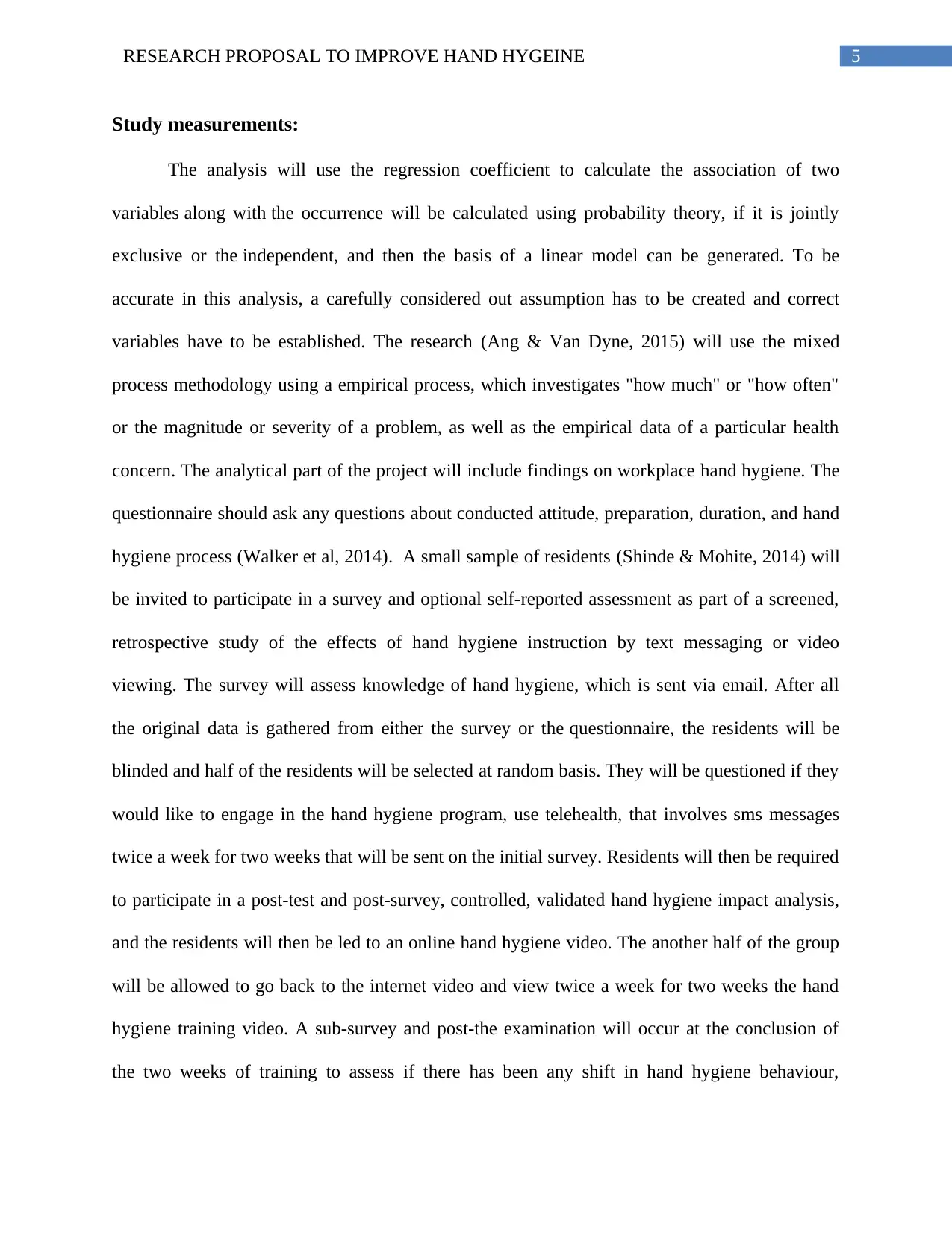
5RESEARCH PROPOSAL TO IMPROVE HAND HYGEINE
Study measurements:
The analysis will use the regression coefficient to calculate the association of two
variables along with the occurrence will be calculated using probability theory, if it is jointly
exclusive or the independent, and then the basis of a linear model can be generated. To be
accurate in this analysis, a carefully considered out assumption has to be created and correct
variables have to be established. The research (Ang & Van Dyne, 2015) will use the mixed
process methodology using a empirical process, which investigates "how much" or "how often"
or the magnitude or severity of a problem, as well as the empirical data of a particular health
concern. The analytical part of the project will include findings on workplace hand hygiene. The
questionnaire should ask any questions about conducted attitude, preparation, duration, and hand
hygiene process (Walker et al, 2014). A small sample of residents (Shinde & Mohite, 2014) will
be invited to participate in a survey and optional self-reported assessment as part of a screened,
retrospective study of the effects of hand hygiene instruction by text messaging or video
viewing. The survey will assess knowledge of hand hygiene, which is sent via email. After all
the original data is gathered from either the survey or the questionnaire, the residents will be
blinded and half of the residents will be selected at random basis. They will be questioned if they
would like to engage in the hand hygiene program, use telehealth, that involves sms messages
twice a week for two weeks that will be sent on the initial survey. Residents will then be required
to participate in a post-test and post-survey, controlled, validated hand hygiene impact analysis,
and the residents will then be led to an online hand hygiene video. The another half of the group
will be allowed to go back to the internet video and view twice a week for two weeks the hand
hygiene training video. A sub-survey and post-the examination will occur at the conclusion of
the two weeks of training to assess if there has been any shift in hand hygiene behaviour,
Study measurements:
The analysis will use the regression coefficient to calculate the association of two
variables along with the occurrence will be calculated using probability theory, if it is jointly
exclusive or the independent, and then the basis of a linear model can be generated. To be
accurate in this analysis, a carefully considered out assumption has to be created and correct
variables have to be established. The research (Ang & Van Dyne, 2015) will use the mixed
process methodology using a empirical process, which investigates "how much" or "how often"
or the magnitude or severity of a problem, as well as the empirical data of a particular health
concern. The analytical part of the project will include findings on workplace hand hygiene. The
questionnaire should ask any questions about conducted attitude, preparation, duration, and hand
hygiene process (Walker et al, 2014). A small sample of residents (Shinde & Mohite, 2014) will
be invited to participate in a survey and optional self-reported assessment as part of a screened,
retrospective study of the effects of hand hygiene instruction by text messaging or video
viewing. The survey will assess knowledge of hand hygiene, which is sent via email. After all
the original data is gathered from either the survey or the questionnaire, the residents will be
blinded and half of the residents will be selected at random basis. They will be questioned if they
would like to engage in the hand hygiene program, use telehealth, that involves sms messages
twice a week for two weeks that will be sent on the initial survey. Residents will then be required
to participate in a post-test and post-survey, controlled, validated hand hygiene impact analysis,
and the residents will then be led to an online hand hygiene video. The another half of the group
will be allowed to go back to the internet video and view twice a week for two weeks the hand
hygiene training video. A sub-survey and post-the examination will occur at the conclusion of
the two weeks of training to assess if there has been any shift in hand hygiene behaviour,
⊘ This is a preview!⊘
Do you want full access?
Subscribe today to unlock all pages.

Trusted by 1+ million students worldwide
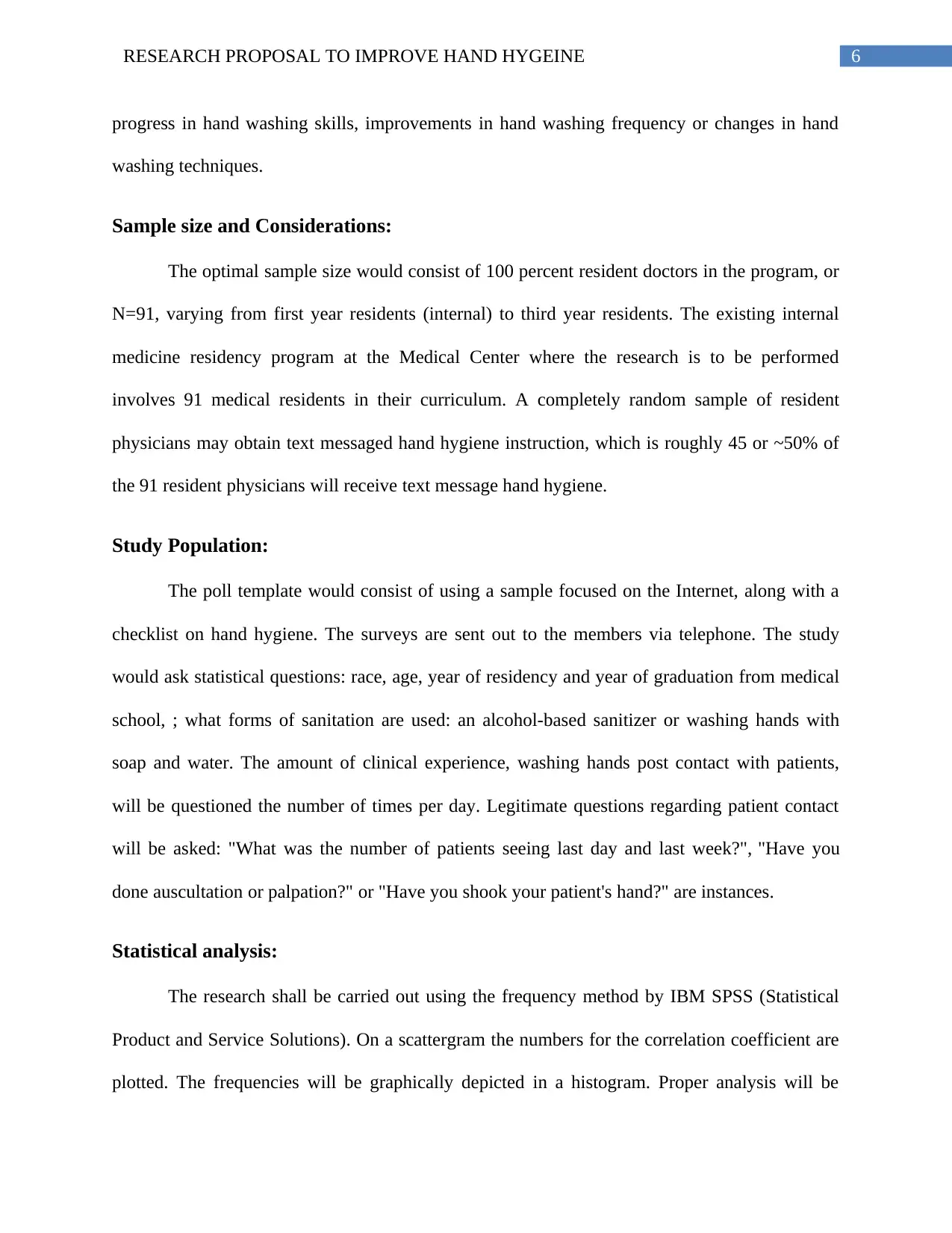
6RESEARCH PROPOSAL TO IMPROVE HAND HYGEINE
progress in hand washing skills, improvements in hand washing frequency or changes in hand
washing techniques.
Sample size and Considerations:
The optimal sample size would consist of 100 percent resident doctors in the program, or
N=91, varying from first year residents (internal) to third year residents. The existing internal
medicine residency program at the Medical Center where the research is to be performed
involves 91 medical residents in their curriculum. A completely random sample of resident
physicians may obtain text messaged hand hygiene instruction, which is roughly 45 or ~50% of
the 91 resident physicians will receive text message hand hygiene.
Study Population:
The poll template would consist of using a sample focused on the Internet, along with a
checklist on hand hygiene. The surveys are sent out to the members via telephone. The study
would ask statistical questions: race, age, year of residency and year of graduation from medical
school, ; what forms of sanitation are used: an alcohol-based sanitizer or washing hands with
soap and water. The amount of clinical experience, washing hands post contact with patients,
will be questioned the number of times per day. Legitimate questions regarding patient contact
will be asked: "What was the number of patients seeing last day and last week?", "Have you
done auscultation or palpation?" or "Have you shook your patient's hand?" are instances.
Statistical analysis:
The research shall be carried out using the frequency method by IBM SPSS (Statistical
Product and Service Solutions). On a scattergram the numbers for the correlation coefficient are
plotted. The frequencies will be graphically depicted in a histogram. Proper analysis will be
progress in hand washing skills, improvements in hand washing frequency or changes in hand
washing techniques.
Sample size and Considerations:
The optimal sample size would consist of 100 percent resident doctors in the program, or
N=91, varying from first year residents (internal) to third year residents. The existing internal
medicine residency program at the Medical Center where the research is to be performed
involves 91 medical residents in their curriculum. A completely random sample of resident
physicians may obtain text messaged hand hygiene instruction, which is roughly 45 or ~50% of
the 91 resident physicians will receive text message hand hygiene.
Study Population:
The poll template would consist of using a sample focused on the Internet, along with a
checklist on hand hygiene. The surveys are sent out to the members via telephone. The study
would ask statistical questions: race, age, year of residency and year of graduation from medical
school, ; what forms of sanitation are used: an alcohol-based sanitizer or washing hands with
soap and water. The amount of clinical experience, washing hands post contact with patients,
will be questioned the number of times per day. Legitimate questions regarding patient contact
will be asked: "What was the number of patients seeing last day and last week?", "Have you
done auscultation or palpation?" or "Have you shook your patient's hand?" are instances.
Statistical analysis:
The research shall be carried out using the frequency method by IBM SPSS (Statistical
Product and Service Solutions). On a scattergram the numbers for the correlation coefficient are
plotted. The frequencies will be graphically depicted in a histogram. Proper analysis will be
Paraphrase This Document
Need a fresh take? Get an instant paraphrase of this document with our AI Paraphraser
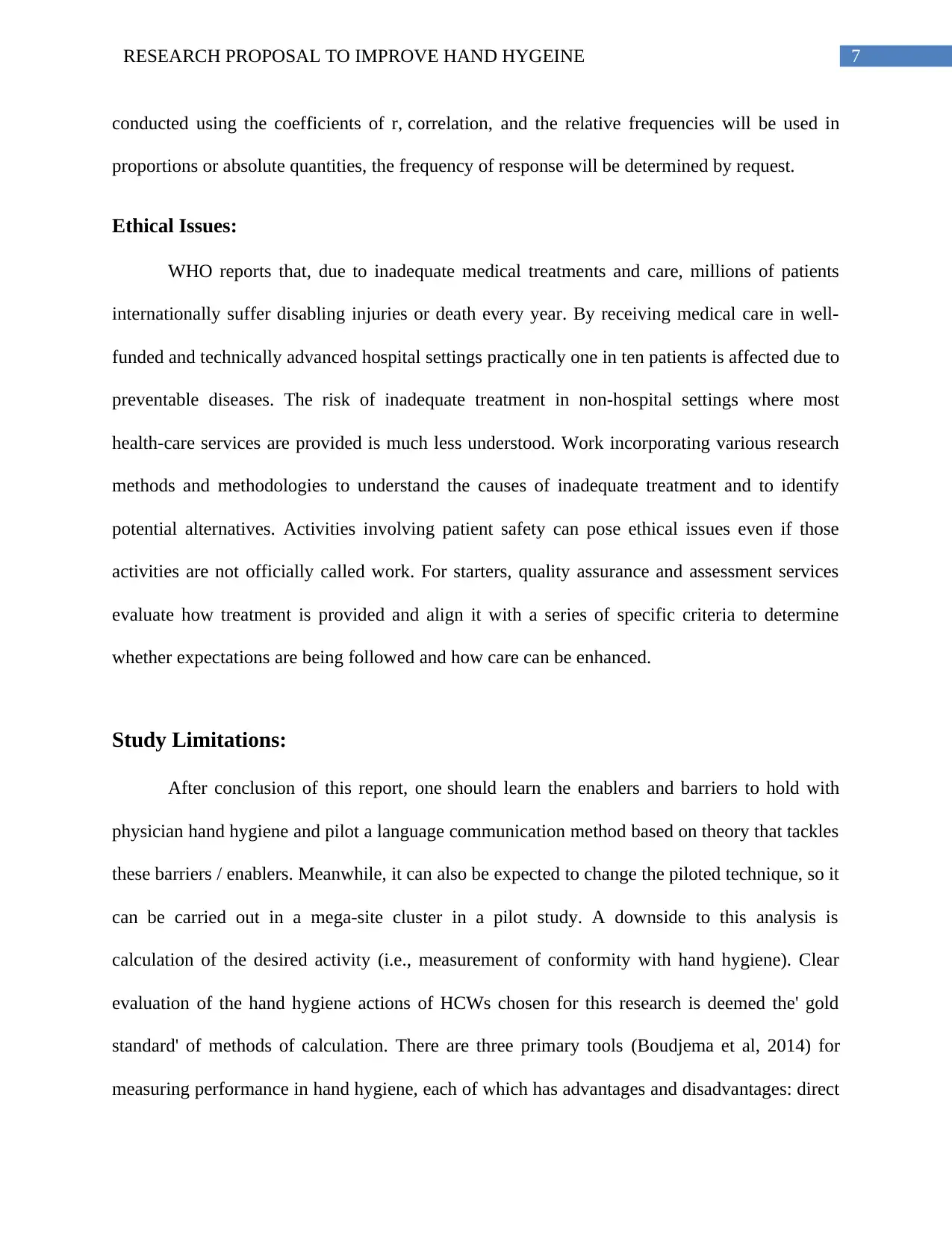
7RESEARCH PROPOSAL TO IMPROVE HAND HYGEINE
conducted using the coefficients of r, correlation, and the relative frequencies will be used in
proportions or absolute quantities, the frequency of response will be determined by request.
Ethical Issues:
WHO reports that, due to inadequate medical treatments and care, millions of patients
internationally suffer disabling injuries or death every year. By receiving medical care in well-
funded and technically advanced hospital settings practically one in ten patients is affected due to
preventable diseases. The risk of inadequate treatment in non-hospital settings where most
health-care services are provided is much less understood. Work incorporating various research
methods and methodologies to understand the causes of inadequate treatment and to identify
potential alternatives. Activities involving patient safety can pose ethical issues even if those
activities are not officially called work. For starters, quality assurance and assessment services
evaluate how treatment is provided and align it with a series of specific criteria to determine
whether expectations are being followed and how care can be enhanced.
Study Limitations:
After conclusion of this report, one should learn the enablers and barriers to hold with
physician hand hygiene and pilot a language communication method based on theory that tackles
these barriers / enablers. Meanwhile, it can also be expected to change the piloted technique, so it
can be carried out in a mega-site cluster in a pilot study. A downside to this analysis is
calculation of the desired activity (i.e., measurement of conformity with hand hygiene). Clear
evaluation of the hand hygiene actions of HCWs chosen for this research is deemed the' gold
standard' of methods of calculation. There are three primary tools (Boudjema et al, 2014) for
measuring performance in hand hygiene, each of which has advantages and disadvantages: direct
conducted using the coefficients of r, correlation, and the relative frequencies will be used in
proportions or absolute quantities, the frequency of response will be determined by request.
Ethical Issues:
WHO reports that, due to inadequate medical treatments and care, millions of patients
internationally suffer disabling injuries or death every year. By receiving medical care in well-
funded and technically advanced hospital settings practically one in ten patients is affected due to
preventable diseases. The risk of inadequate treatment in non-hospital settings where most
health-care services are provided is much less understood. Work incorporating various research
methods and methodologies to understand the causes of inadequate treatment and to identify
potential alternatives. Activities involving patient safety can pose ethical issues even if those
activities are not officially called work. For starters, quality assurance and assessment services
evaluate how treatment is provided and align it with a series of specific criteria to determine
whether expectations are being followed and how care can be enhanced.
Study Limitations:
After conclusion of this report, one should learn the enablers and barriers to hold with
physician hand hygiene and pilot a language communication method based on theory that tackles
these barriers / enablers. Meanwhile, it can also be expected to change the piloted technique, so it
can be carried out in a mega-site cluster in a pilot study. A downside to this analysis is
calculation of the desired activity (i.e., measurement of conformity with hand hygiene). Clear
evaluation of the hand hygiene actions of HCWs chosen for this research is deemed the' gold
standard' of methods of calculation. There are three primary tools (Boudjema et al, 2014) for
measuring performance in hand hygiene, each of which has advantages and disadvantages: direct
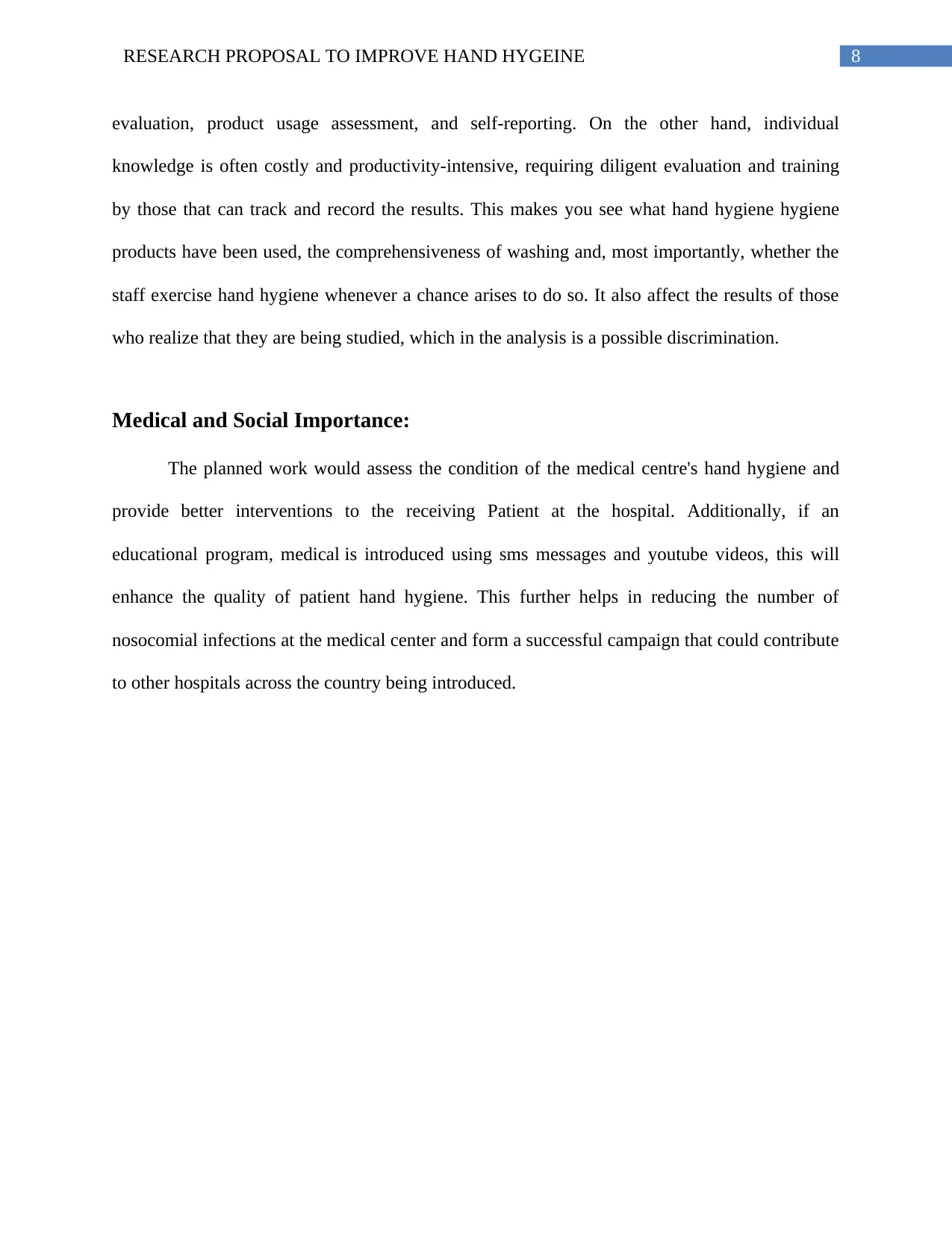
8RESEARCH PROPOSAL TO IMPROVE HAND HYGEINE
evaluation, product usage assessment, and self-reporting. On the other hand, individual
knowledge is often costly and productivity-intensive, requiring diligent evaluation and training
by those that can track and record the results. This makes you see what hand hygiene hygiene
products have been used, the comprehensiveness of washing and, most importantly, whether the
staff exercise hand hygiene whenever a chance arises to do so. It also affect the results of those
who realize that they are being studied, which in the analysis is a possible discrimination.
Medical and Social Importance:
The planned work would assess the condition of the medical centre's hand hygiene and
provide better interventions to the receiving Patient at the hospital. Additionally, if an
educational program, medical is introduced using sms messages and youtube videos, this will
enhance the quality of patient hand hygiene. This further helps in reducing the number of
nosocomial infections at the medical center and form a successful campaign that could contribute
to other hospitals across the country being introduced.
evaluation, product usage assessment, and self-reporting. On the other hand, individual
knowledge is often costly and productivity-intensive, requiring diligent evaluation and training
by those that can track and record the results. This makes you see what hand hygiene hygiene
products have been used, the comprehensiveness of washing and, most importantly, whether the
staff exercise hand hygiene whenever a chance arises to do so. It also affect the results of those
who realize that they are being studied, which in the analysis is a possible discrimination.
Medical and Social Importance:
The planned work would assess the condition of the medical centre's hand hygiene and
provide better interventions to the receiving Patient at the hospital. Additionally, if an
educational program, medical is introduced using sms messages and youtube videos, this will
enhance the quality of patient hand hygiene. This further helps in reducing the number of
nosocomial infections at the medical center and form a successful campaign that could contribute
to other hospitals across the country being introduced.
⊘ This is a preview!⊘
Do you want full access?
Subscribe today to unlock all pages.

Trusted by 1+ million students worldwide
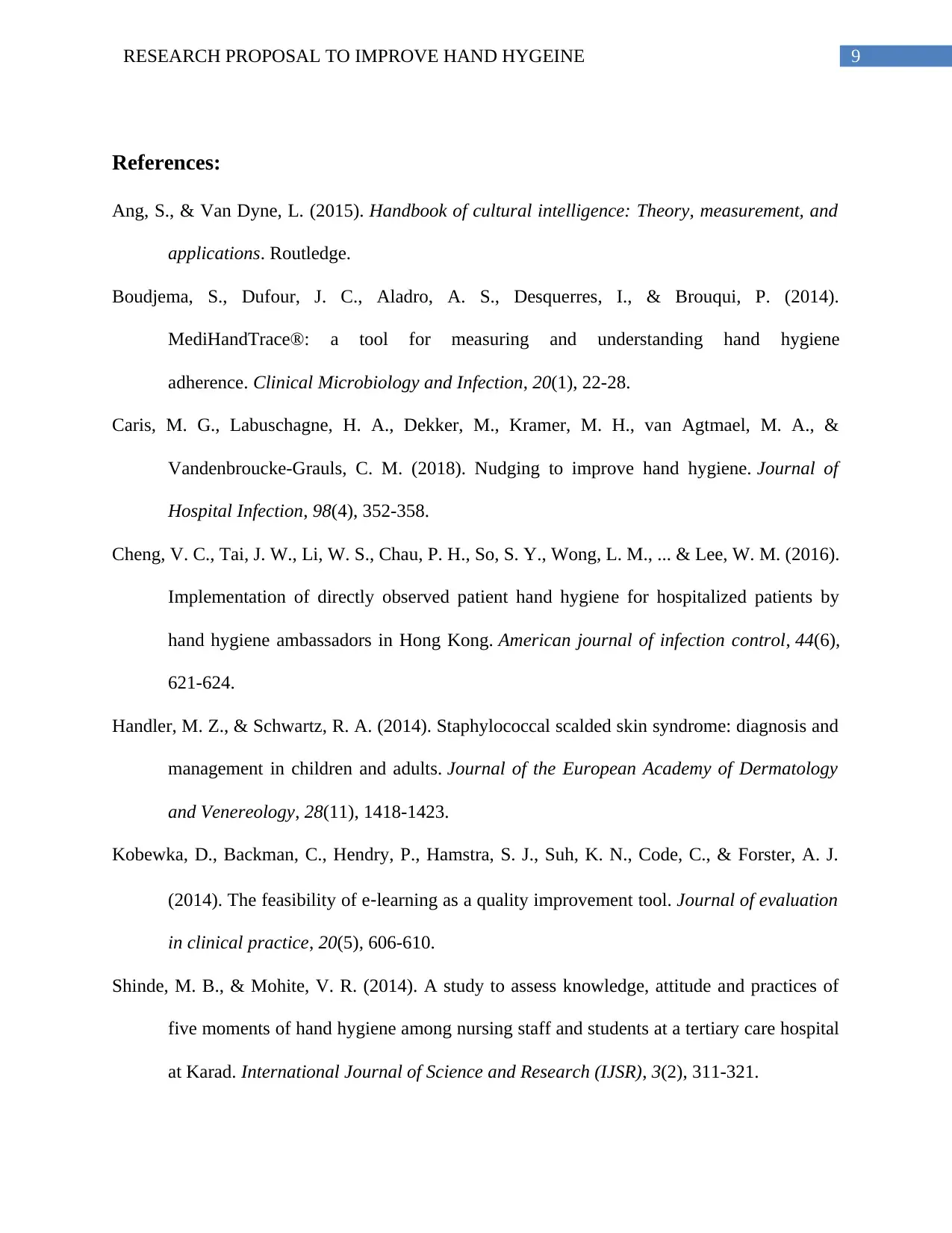
9RESEARCH PROPOSAL TO IMPROVE HAND HYGEINE
References:
Ang, S., & Van Dyne, L. (2015). Handbook of cultural intelligence: Theory, measurement, and
applications. Routledge.
Boudjema, S., Dufour, J. C., Aladro, A. S., Desquerres, I., & Brouqui, P. (2014).
MediHandTrace®: a tool for measuring and understanding hand hygiene
adherence. Clinical Microbiology and Infection, 20(1), 22-28.
Caris, M. G., Labuschagne, H. A., Dekker, M., Kramer, M. H., van Agtmael, M. A., &
Vandenbroucke-Grauls, C. M. (2018). Nudging to improve hand hygiene. Journal of
Hospital Infection, 98(4), 352-358.
Cheng, V. C., Tai, J. W., Li, W. S., Chau, P. H., So, S. Y., Wong, L. M., ... & Lee, W. M. (2016).
Implementation of directly observed patient hand hygiene for hospitalized patients by
hand hygiene ambassadors in Hong Kong. American journal of infection control, 44(6),
621-624.
Handler, M. Z., & Schwartz, R. A. (2014). Staphylococcal scalded skin syndrome: diagnosis and
management in children and adults. Journal of the European Academy of Dermatology
and Venereology, 28(11), 1418-1423.
Kobewka, D., Backman, C., Hendry, P., Hamstra, S. J., Suh, K. N., Code, C., & Forster, A. J.
(2014). The feasibility of e‐learning as a quality improvement tool. Journal of evaluation
in clinical practice, 20(5), 606-610.
Shinde, M. B., & Mohite, V. R. (2014). A study to assess knowledge, attitude and practices of
five moments of hand hygiene among nursing staff and students at a tertiary care hospital
at Karad. International Journal of Science and Research (IJSR), 3(2), 311-321.
References:
Ang, S., & Van Dyne, L. (2015). Handbook of cultural intelligence: Theory, measurement, and
applications. Routledge.
Boudjema, S., Dufour, J. C., Aladro, A. S., Desquerres, I., & Brouqui, P. (2014).
MediHandTrace®: a tool for measuring and understanding hand hygiene
adherence. Clinical Microbiology and Infection, 20(1), 22-28.
Caris, M. G., Labuschagne, H. A., Dekker, M., Kramer, M. H., van Agtmael, M. A., &
Vandenbroucke-Grauls, C. M. (2018). Nudging to improve hand hygiene. Journal of
Hospital Infection, 98(4), 352-358.
Cheng, V. C., Tai, J. W., Li, W. S., Chau, P. H., So, S. Y., Wong, L. M., ... & Lee, W. M. (2016).
Implementation of directly observed patient hand hygiene for hospitalized patients by
hand hygiene ambassadors in Hong Kong. American journal of infection control, 44(6),
621-624.
Handler, M. Z., & Schwartz, R. A. (2014). Staphylococcal scalded skin syndrome: diagnosis and
management in children and adults. Journal of the European Academy of Dermatology
and Venereology, 28(11), 1418-1423.
Kobewka, D., Backman, C., Hendry, P., Hamstra, S. J., Suh, K. N., Code, C., & Forster, A. J.
(2014). The feasibility of e‐learning as a quality improvement tool. Journal of evaluation
in clinical practice, 20(5), 606-610.
Shinde, M. B., & Mohite, V. R. (2014). A study to assess knowledge, attitude and practices of
five moments of hand hygiene among nursing staff and students at a tertiary care hospital
at Karad. International Journal of Science and Research (IJSR), 3(2), 311-321.
Paraphrase This Document
Need a fresh take? Get an instant paraphrase of this document with our AI Paraphraser
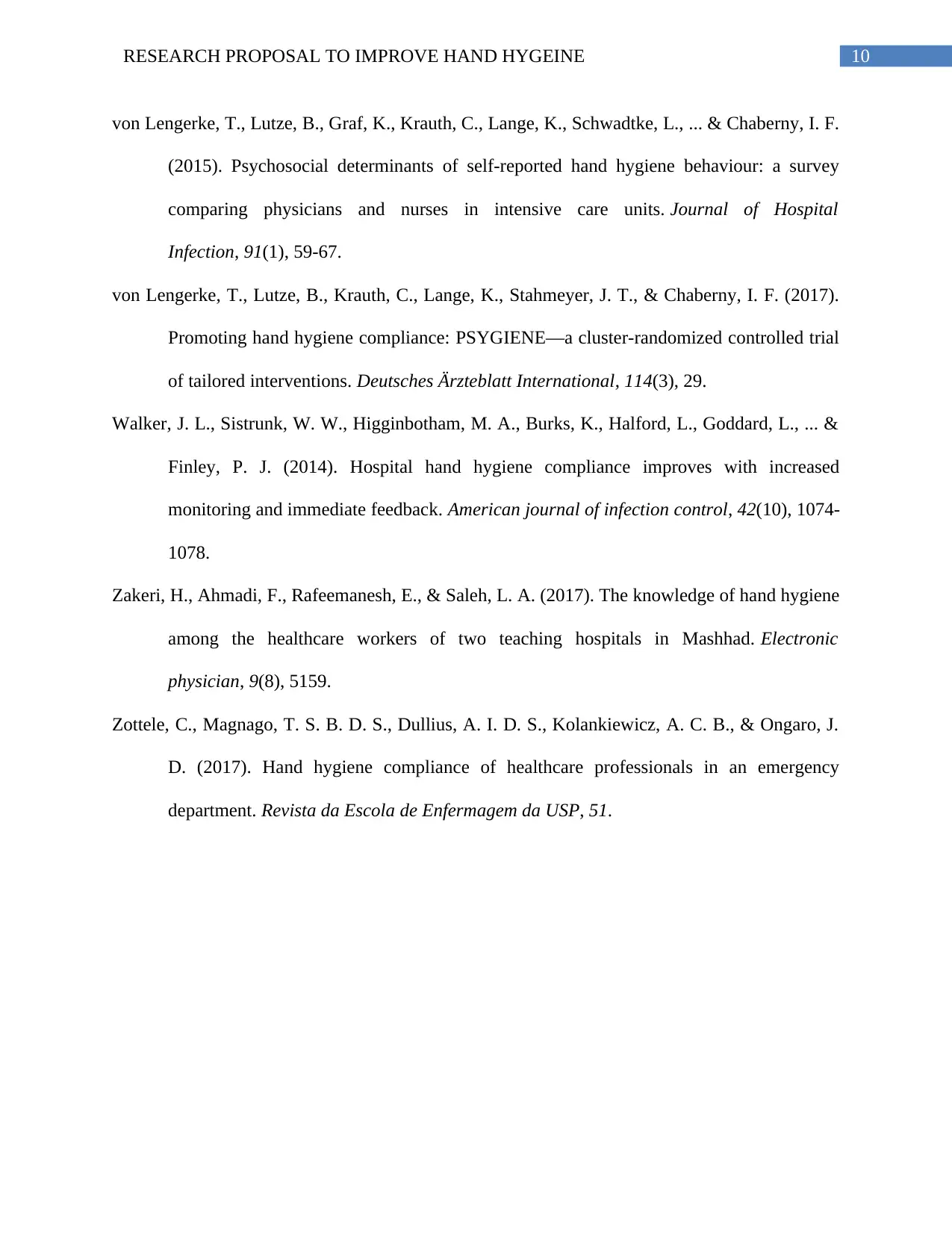
10RESEARCH PROPOSAL TO IMPROVE HAND HYGEINE
von Lengerke, T., Lutze, B., Graf, K., Krauth, C., Lange, K., Schwadtke, L., ... & Chaberny, I. F.
(2015). Psychosocial determinants of self-reported hand hygiene behaviour: a survey
comparing physicians and nurses in intensive care units. Journal of Hospital
Infection, 91(1), 59-67.
von Lengerke, T., Lutze, B., Krauth, C., Lange, K., Stahmeyer, J. T., & Chaberny, I. F. (2017).
Promoting hand hygiene compliance: PSYGIENE—a cluster-randomized controlled trial
of tailored interventions. Deutsches Ärzteblatt International, 114(3), 29.
Walker, J. L., Sistrunk, W. W., Higginbotham, M. A., Burks, K., Halford, L., Goddard, L., ... &
Finley, P. J. (2014). Hospital hand hygiene compliance improves with increased
monitoring and immediate feedback. American journal of infection control, 42(10), 1074-
1078.
Zakeri, H., Ahmadi, F., Rafeemanesh, E., & Saleh, L. A. (2017). The knowledge of hand hygiene
among the healthcare workers of two teaching hospitals in Mashhad. Electronic
physician, 9(8), 5159.
Zottele, C., Magnago, T. S. B. D. S., Dullius, A. I. D. S., Kolankiewicz, A. C. B., & Ongaro, J.
D. (2017). Hand hygiene compliance of healthcare professionals in an emergency
department. Revista da Escola de Enfermagem da USP, 51.
von Lengerke, T., Lutze, B., Graf, K., Krauth, C., Lange, K., Schwadtke, L., ... & Chaberny, I. F.
(2015). Psychosocial determinants of self-reported hand hygiene behaviour: a survey
comparing physicians and nurses in intensive care units. Journal of Hospital
Infection, 91(1), 59-67.
von Lengerke, T., Lutze, B., Krauth, C., Lange, K., Stahmeyer, J. T., & Chaberny, I. F. (2017).
Promoting hand hygiene compliance: PSYGIENE—a cluster-randomized controlled trial
of tailored interventions. Deutsches Ärzteblatt International, 114(3), 29.
Walker, J. L., Sistrunk, W. W., Higginbotham, M. A., Burks, K., Halford, L., Goddard, L., ... &
Finley, P. J. (2014). Hospital hand hygiene compliance improves with increased
monitoring and immediate feedback. American journal of infection control, 42(10), 1074-
1078.
Zakeri, H., Ahmadi, F., Rafeemanesh, E., & Saleh, L. A. (2017). The knowledge of hand hygiene
among the healthcare workers of two teaching hospitals in Mashhad. Electronic
physician, 9(8), 5159.
Zottele, C., Magnago, T. S. B. D. S., Dullius, A. I. D. S., Kolankiewicz, A. C. B., & Ongaro, J.
D. (2017). Hand hygiene compliance of healthcare professionals in an emergency
department. Revista da Escola de Enfermagem da USP, 51.
1 out of 11
Related Documents
Your All-in-One AI-Powered Toolkit for Academic Success.
+13062052269
info@desklib.com
Available 24*7 on WhatsApp / Email
![[object Object]](/_next/static/media/star-bottom.7253800d.svg)
Unlock your academic potential
Copyright © 2020–2025 A2Z Services. All Rights Reserved. Developed and managed by ZUCOL.





